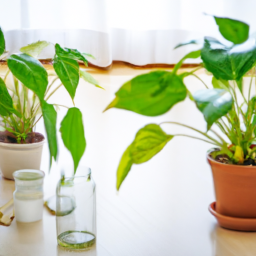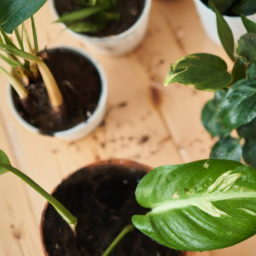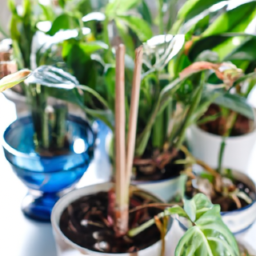
Are you thinking about adding some greenery to your indoor space? When growing indoor plants, there are a few key factors to consider in order to ensure your plants thrive. From choosing the right plants for your space to providing proper care and maintenance, indoor gardening can be a rewarding and enjoyable experience. In this blog post, we will discuss some tips and tricks for successfully growing indoor plants, so you can create a lush and vibrant oasis in your home. Whether you’re a seasoned plant parent or a beginner looking to develop your green thumb, we’ve got you covered. Let’s dive in and explore the wonderful world of indoor gardening!
Choosing the Right Indoor Plants for Your Space
Welcome to the world of indoor gardening! Whether you’re a seasoned plant parent or just starting out, choosing the right indoor plants for your space is crucial for their growth and overall well-being. In this guide, we’ll walk you through the steps to help you select the perfect plants for your home or office.
Assessing Your Space
The first step in choosing indoor plants is to assess your space. Consider the amount of natural light that enters the room, as this will determine the types of plants that will thrive in that environment. If you have a sunny window, you can opt for plants that require bright, indirect light such as succulents, cacti, or spider plants. On the other hand, if your space is low-light, consider plants like pothos, snake plants, or peace lilies that can thrive in shaded areas.
Next, think about the temperature and humidity levels in your space. Some plants, like tropical varieties, prefer warm and humid conditions, while others, like cacti and succulents, thrive in drier environments. Make sure to choose plants that will be comfortable in the climate of your space to ensure their health and growth.
Lastly, consider the size and layout of your space. If you have limited space, opt for smaller plants like air plants or herbs that can be placed on shelves or countertops. If you have a larger area to work with, you can choose larger plants like fiddle leaf figs or monstera deliciosas to make a statement in your space.
Choosing the Right Plants
Once you’ve assessed your space, it’s time to choose the right plants that will thrive in that environment. Consider your level of experience with gardening – if you’re a beginner, opt for low-maintenance plants like pothos, snake plants, or spider plants that are easy to care for and forgiving of occasional neglect.
If you have more experience with indoor gardening, you can experiment with plants that have specific care requirements, such as orchids, ferns, or bonsai trees. Make sure to research the care instructions for each plant you choose to ensure you can provide them with the proper conditions for growth.
Consider the aesthetic of your space when choosing plants. Think about the color, texture, and shape of the leaves to create a cohesive and visually appealing indoor garden. Mix and match different plant varieties to add interest and personality to your space.
Lastly, consider the air-purifying qualities of indoor plants. Many plants, such as peace lilies, snake plants, and spider plants, can help improve air quality by removing toxins and pollutants from the air. Choose plants that not only enhance the beauty of your space but also contribute to a healthier indoor environment.
Caring for Your Indoor Plants
Once you’ve selected the right plants for your space, it’s important to provide them with the proper care to ensure their growth and longevity. Make sure to water your plants according to their specific needs – some plants prefer to dry out between waterings, while others require more frequent watering.
Monitor the humidity levels in your space and consider using a humidifier or pebble tray to increase moisture for plants that require higher humidity. Rotate your plants regularly to ensure even growth and exposure to light, and dust their leaves to keep them clean and free from pests.
Lastly, pay attention to any signs of stress or disease in your plants, such as yellowing leaves, wilting, or pests. Act quickly to address any issues and provide the necessary care to help your plants recover. With proper care and attention, your indoor plants will thrive and bring beauty and life to your space.

Essential Tips for Watering Indoor Plants
Understanding the Watering Needs of Indoor Plants
When it comes to watering indoor plants, it is important to understand the specific needs of each plant. Different plants have different requirements when it comes to watering, so it is crucial to do your research and make sure you are providing the right amount of water for each plant.
One common mistake that many people make is overwatering their indoor plants. Overwatering can lead to root rot and other issues that can harm your plants. It is important to let the soil dry out between waterings to prevent overwatering. On the other hand, underwatering can also be detrimental to your plants, so it is important to find the right balance.
One way to determine if your plants need water is to stick your finger into the soil. If the top inch of soil is dry, it is time to water your plants. You can also use a moisture meter to help you determine when to water your plants. Pay attention to the specific needs of each plant and adjust your watering schedule accordingly.
Another important factor to consider when watering indoor plants is the type of water you use. Tap water can contain chemicals such as chlorine and fluoride that can be harmful to your plants. It is best to use filtered water or rainwater to water your indoor plants. Make sure the water is at room temperature before watering your plants, as cold water can shock the roots of your plants.
Best Practices for Watering Indoor Plants
When watering your indoor plants, it is important to water the soil directly and avoid getting water on the leaves. Watering the leaves can lead to issues such as mold and mildew, so it is best to water the soil at the base of the plant. Use a watering can with a narrow spout to ensure that you are watering the soil directly.
It is also important to water your plants in the morning, as this allows the plants to absorb the water throughout the day. Avoid watering your plants in the evening, as this can lead to issues such as mold and mildew. Make sure to water your plants thoroughly, allowing the water to drain out of the bottom of the pot. This helps to prevent water from pooling at the bottom of the pot, which can lead to root rot.
Another important tip for watering indoor plants is to use a pot with drainage holes. This allows excess water to drain out of the pot, preventing water from pooling at the bottom. If your pot does not have drainage holes, you can add a layer of gravel to the bottom of the pot to help with drainage.
Common Mistakes to Avoid When Watering Indoor Plants
One common mistake that many people make when watering indoor plants is using a schedule to determine when to water their plants. It is important to pay attention to the specific needs of each plant and adjust your watering schedule accordingly. Some plants may need more water than others, so it is important to do your research and make sure you are providing the right amount of water for each plant.
Another common mistake is using the wrong type of water to water your indoor plants. Tap water can contain chemicals that can be harmful to your plants, so it is best to use filtered water or rainwater. Make sure the water is at room temperature before watering your plants, as cold water can shock the roots of your plants.
Overwatering is another common mistake that can harm your indoor plants. It is important to let the soil dry out between waterings to prevent overwatering. Pay attention to the specific needs of each plant and adjust your watering schedule accordingly to ensure the health and vitality of your indoor plants.

Common Pest Problems When Growing Indoor Plants
Identifying Common Pests
When growing indoor plants, it is important to be aware of the common pest problems that can arise. One of the most common pests that indoor plants face is the spider mite. These tiny insects can be difficult to spot, but they can cause significant damage to your plants if left untreated. Look for webbing on the leaves and stems of your plants, as well as yellowing or stippling of the leaves.
Another common pest is the aphid. These small, pear-shaped insects can be found clustered on the undersides of leaves, sucking the sap from your plants. Look for distorted or yellowing leaves, as well as a sticky substance known as honeydew on the leaves and stems.
Fungus gnats are another common pest that can be a nuisance for indoor plants. These small, black flies lay their eggs in the soil of your plants, where the larvae feed on the roots. Look for tiny, black flies hovering around your plants, as well as yellowing or wilting leaves.
Treating Pest Problems
When dealing with pest problems in your indoor plants, it is important to act quickly to prevent further damage. One natural remedy for spider mites is to spray your plants with a mixture of water and neem oil. This will help to suffocate the mites and prevent them from spreading. For aphids, you can try spraying your plants with a mixture of water and dish soap, which will help to kill the insects on contact.
To get rid of fungus gnats, you can try placing sticky traps near your plants to catch the adult flies. You can also let the soil of your plants dry out between waterings, as the larvae of fungus gnats thrive in moist soil. If these methods do not work, you may need to repot your plants in fresh soil to get rid of the larvae.
It is important to regularly inspect your plants for signs of pest problems, as early detection can help prevent further damage. You can also try introducing beneficial insects, such as ladybugs or lacewings, to help control pest populations in your indoor garden.
Preventing Future Infestations
To prevent future pest problems in your indoor plants, it is important to practice good plant hygiene. This includes regularly cleaning your plants with a damp cloth to remove dust and debris, as well as removing any dead or decaying plant matter from the soil. You can also try isolating new plants from your existing plants for a few weeks to prevent the spread of pests.
Another way to prevent pest problems is to avoid overwatering your plants, as this can create a moist environment that is ideal for pests to thrive. Make sure to water your plants only when the top inch of soil is dry, and be sure to empty any excess water from the saucer to prevent standing water. You can also try using a well-draining soil mix to help prevent root rot and other moisture-related issues.
By following these tips and being vigilant in monitoring your indoor plants, you can help prevent and treat common pest problems before they become a major issue. Remember to always research the specific pests affecting your plants and choose the best treatment method for your situation.
Let’s wrap up what we learned
So, you’ve decided to bring some greenery into your home by growing indoor plants. Congratulations! Indoor plants not only add a touch of nature to your living space but also have numerous benefits for your health and well-being. However, before you start filling your home with plants, there are a few things you should keep in mind to ensure that your indoor garden thrives.
First and foremost, consider the lighting conditions in your home. Different plants have different light requirements, so it’s important to place your plants in areas where they can receive the right amount of sunlight. Additionally, make sure to water your plants regularly but be careful not to overwater them, as this can lead to root rot. Finally, don’t forget to fertilize your plants every few weeks to ensure they have the nutrients they need to grow and flourish. With a little bit of care and attention, you’ll soon have a beautiful indoor garden that will bring joy and tranquility to your home.
Curious Minds Asked, We Responded. Frequently Asked Questions:
Q1. What are the best indoor plants for beginners?
A1. If you’re new to indoor gardening, some easy-to-care-for plants include pothos, spider plants, and snake plants. These plants require minimal maintenance and can thrive in various lighting conditions.
Q2. How often should I water my indoor plants?
A2. The frequency of watering indoor plants varies depending on the type of plant, the size of the pot, and the humidity levels in your home. A general rule of thumb is to water when the top inch of soil feels dry to the touch.
Q3. What is the best lighting for indoor plants?
A3. Most indoor plants thrive in bright, indirect sunlight. Place your plants near a window where they can receive plenty of natural light without being exposed to direct sunlight, which can cause sunburn.
Q4. How can I prevent pests from infesting my indoor plants?
A4. To prevent pests like spider mites and aphids from infesting your indoor plants, regularly inspect the leaves for any signs of infestation. You can also use natural remedies like neem oil or insecticidal soap to keep pests at bay.
Q5. What are some common mistakes to avoid when growing indoor plants?
A5. Some common mistakes to avoid when growing indoor plants include overwatering, using the wrong type of soil, and neglecting to dust the leaves. Remember to research the specific care requirements of each plant to ensure they thrive in your home.

James Wong is a renowned ethnobotanist, plant scientist, and local television presenter. With a passion for demystifying plant science, he is known for translating complex botanical concepts into practical advice for everyday plant enthusiasts. James’s expertise spans from traditional gardening to cutting-edge plant technologies, making his insights accessible and informative.


